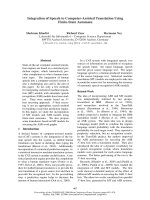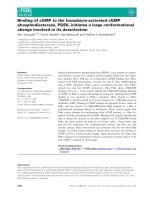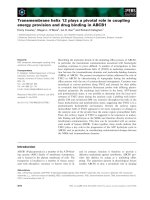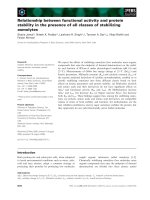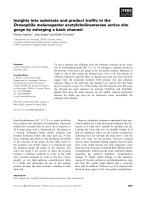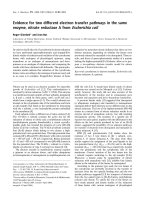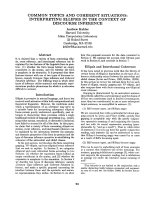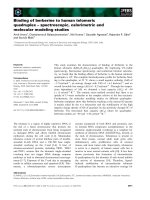Báo cáo khoa học: Acylation of lysophosphatidylcholine plays a key role in the response of monocytes to lipopolysaccharide ppt
Bạn đang xem bản rút gọn của tài liệu. Xem và tải ngay bản đầy đủ của tài liệu tại đây (228.64 KB, 7 trang )
Acylation of lysophosphatidylcholine plays a key role
in the response of monocytes to lipopolysaccharide
Bernhard Schmid
1,2
, Michael J. Finnen
3
, John L. Harwood
1
and Simon K. Jackson
2
1
School of Biosciences, Cardiff University, UK;
2
University of Wales College of Medicine, Cardiff, UK; and
3
Yamanouchi Research Institute, Oxford, UK
Mononuclear phagocytes play a pivotal role in the pro-
gression of septic shock by producing tumor necrosis factor-
a (TNF-a) and other inflammatory mediators in response to
lipopolysaccharide (LPS) from Gram-negative bacteria. Our
previous studies have shown monocyte and macrophage
activation correlate with changes in membrane phospholipid
composition, mediated by acyltransferases. Interferon-c
(IFN-c), which activates and primes these cells for enhanced
inflammatory responses to LPS, was found to selectively
activate lysophosphatidylcholine acyltransferase (LPCAT)
(P < 0.05) but not lysophosphatidic acid acyltransferase
(LPAAT) activity. When used to prime the human mono-
cytic cell line MonoMac 6, the production of TNF-a and
interleukin-6 (IL-6) was approximately five times greater in
cells primed with IFN-c than unprimed cells. Two LPCAT
inhibitors SK&F 98625 (diethyl 7-(3,4,5-triphenyl-2-oxo2,3-
dihydro-imidazole-1-yl)heptane phosphonate) and YM
50201 (3-hydroxyethyl 5,3¢-thiophenyl pyridine) strongly
inhibited (up to 90%) TNF-a and IL-6 production in
response to LPS in both unprimed MonoMac-6 cells and
in cells primed with IFN-c. In similar experiments, these
inhibitors also substantially decreased the response of both
primed and unprimed peripheral blood mononuclear cells
to LPS. Sequence-based amplification methods showed that
SK&F 98625 inhibited TNF-a production by decreasing
TNF-a mRNA levels in MonoMac-6 cells. Taken together,
the data from these studies suggest that LPCAT is a key
enzyme in both the pathways of activation (priming) and the
inflammatory response to LPS in monocytes.
Keywords: lysophosphatidylcholine acyltransferase; lyso-
phosphosphatidate acyltransferase; inflammatory response;
lipopolysaccharide.
Endotoxin, the lipopolysaccharide (LPS) component of the
cell walls of Gram-negative bacteria, is an important
microbial molecular pattern that initiates inflammatory
and coagulation reactions as part of the host innate immune
response to infection. However, excessive inflammatory
responses to LPS can lead to septic shock.
Many of the deleterious effects of LPS are mediated by
inflammatory cytokines including tumor necrosis factor
(TNF)-a, interleukin (IL)-1 and IL-6 produced by mono-
nuclear phagocytes (e.g. monocytes and macrophages) [1].
TNF-a has been shown to be a key mediator in experimen-
tal LPS-induced septic shock as neutralizing antibodies to
TNF-a prevent mortality [2,3] and TNF-a receptor knock-
out mice are less sensitive to the biological effects of LPS
[4]. Understanding and modulating the production of
LPS-induced mediators such as TNF-a has been the focus
of much research aimed at developing specific therapies for
septic shock.
Studies in our laboratories have been concerned with
elucidating mechanisms of responsiveness to low (nonlethal)
doses of LPS which, we believe, underscore the excessive
inflammatory responses leading to septic shock [5,6]. An
important regulator of LPS-induced biological activity is
interferon (IFN)-c [7,8] and the neutralization of IFN-c
or the deletion of its receptors have been shown to be
protective for the lethal outcomes of several forms of
endotoxic shock [9,10]. An important contribution of IFN-c
to the development of LPS-induced shock is by priming
monocytes/macrophages for increased inflammatory
responsiveness to LPS [11]. The molecular basis for such
priming reactions remain obscure.
In previous studies investigating the priming of mono-
cytes by IFN-c, we showed that this cytokine significantly
modified the phospholipid composition of such cells and
increased the unsaturated fatty acyl groups esterified at the
sn-2 position of phosphatidylcholine (PtdCho) [5,6]. More-
over, we found that IFN-c up-regulated monocyte lysoPC
acyltransferase (LPCAT), a key enzyme in the regulation of
PtdCho fatty acyl composition [6,12]. These results suggest
that LPCAT may regulate the priming of monocytes by
IFN-c and allow increased inflammatory cytokine produc-
tion when these cells are stimulated by LPS. In studies of
T-lymphocyte activation, Szamel and colleagues [13,14]
have demonstrated that activation of the T-cell antigen
Correspondence to S. K. Jackson, Department of Medical Microbio-
logy, University of Wales College of Medicine, Cardiff CF14 4XN,
UK. Fax: + 44 29 20742161, Tel.: + 44 29 20744725,
E-mail: jacksonsk@cardiff.ac.uk
Abbreviations: BSA, bovine serum albumin; DAG, diacylglycerol;
IFN-c, interferon-c; IL-6, interleukin-6; LPS, lipopolysaccharide;
LPAAT, lysophosphatidate acyltransferase; LPCAT, lysophospha-
tidylcholine acyltransferase; NASBA
TM
, nucleic acid sequence based
amplification; PtdOH, phosphatidic acid; PKC, protein kinase C;
PtdCho, phosphatidylcholine; TNF-a, tumor necrosis factor-a.
(Received 11 September 2002, revised 17 March 2003,
accepted 02 May 2003)
Eur. J. Biochem. 270, 2782–2788 (2003) Ó FEBS 2003 doi:10.1046/j.1432-1033.2003.03649.x
receptor/CD3 complex leads to increased incorporation of
polyunsaturated fatty acids into phosphatidylcholine, also
mediated by a LPCAT. Thus, LPCAT may alter the cell
membrane lipid environment so as to favor the assembly of
a signaling complex which can then activate the cellular
response [15].
To elucidate the role of LPCAT in the priming and
activation of monocytes by IFN-c, we have utilized specific
LPCAT inhibitors in an attempt to block this process. We
present herein evidence to show that LPCAT (but not other
acyltransferases) is a key regulator of both the priming of
monocytes by IFN-c and for LPS-initiated TNF-a release.
Materials and methods
Materials
Unless stated otherwise, all reagents were from Sigma
Chemical Co (Poole, UK) and were of the best available
grades. Recombinant human IFN-c was from Peprotech
(London, UK) and diluted in endotoxin-free water (Sigma).
Acyl-transferase inhibitors
The acyltransferase inhibitor SK&F 98625 [diethyl 7-(3,4,
5-triphenyl-2-oxo2,3-dihydro-imidazole-1-yl)heptane phos-
phonate] [16] was purchased from Ferring Research Insti-
tute, Southampton, UK. YM 50201 (3-hydroxyethyl
5,3¢-thiophenyl pyridine), was a kind gift from the Yama-
nouchi Research Institute, Oxford, UK. Their structures are
given in Fig. 1. YM 50201 is a non-competitive inhibitor of
CoA-dependent LPCAT and has been shown to significantly
inhibit the incorporation of [
14
C]linoleic acid into lysophos-
phatidylcholine (M. J. Finnen, unpublished results)
1
.
Cell culture
The acute monocytic leukemia cell line MonoMac-6 [17]
was obtained from the German Collection of Microorgan-
isms and Cell Cultures (Braunschweig, Germany). Cells
were grown in RPMI 1640 medium supplemented with 10%
(v/v) low endotoxin fetal bovine serum, 2 m
ML
-glutamine,
100 UÆmL
)1
penicillin, 100 UÆmL
)1
streptomycin, 1 m
M
sodium pyruvate, 1% (v/v) nonessential amino acids (all
from Life Technologies/Gibco, Paisley, UK) (ÔcompleteÕ
RPMI medium) and 8 lgÆmL
)1
bovine insulin (Sigma).
Cells were grown at 37 °C and 5% (v/v) CO
2
in a humidified
incubator.
To isolate human monocytes, blood (10 mL) was collec-
ted from a healthy volunteer by venipuncture into a
heparinized tube and 2 mL Hypaque-Ficoll (Sigma) was
layered on top. The sample was centrifuged for 20 min at
400 g at room temperature and the mononuclear cell layer
removed to a fresh tube. The pellet was washed twice with
NaCl/P
i
. RPMI 1640 medium without additives was added
to cells to give a cell density of 5 · 10
6
mL
)1
.Toeachwell
of a 24-well plate, 400 lL of the cell suspension was added
and incubated at 37 °C for 2 h. The monolayer was washed
thrice with warm RPMI 1640 medium. Fresh complete
RPMI 1640 medium (with all additives detailed above)
(1 mL) was added and the cells incubated at 37 °Cas
indicated in the legends to the figures.
Cell viability was determined by dye exclusion. Equal
volumes of cell suspension and a 0.4% (v/v) solution of
trypan blue (Sigma) in 20 m
M
NaCl/Tris (pH 7.3) were
mixed. In all experiments viability was greater than 95%.
Preparation of microsomes
MonoMac-6 cells (5 · 10
6
) were incubated in 25 mL
complete RPMI 1640 medium under conditions indicated
in the legend to Fig. 2
2
and harvested by centrifugation at
700 g for 2 min at 4 °C. The pellet was washed twice in
microsomal buffer (pH 7.4) containing sucrose 250 m
M
,
Tris 10 m
M
,MgCl
2
1m
M
,EGTA1m
M
[18]. The cells
were finally resuspended in 1 mL of microsomal buffer and
cells were lysed in an ice-cooled Dounce homogenizer
(2500 r.p.m., 2 min). Successful cell lysis was checked by
light microscopy. Another 1 mL of microsomal buffer was
added. To remove unbroken cells and large debris, the lysate
was centrifuged at 700 g for 5 min and the resulting
supernatant was spun at 20 000 g for 20 min and the final
supernatant at 100 000 g for 1 h. The 100 000 g pellet thus
produced was resuspended in 1 mL microsomal buffer
(above)andstoredat)80 °C. Protein concentration was
determined by the method of Bradford [19].
Measurement of coenzyme A-dependent acyltransferase
activity
Enzyme activity was determined by measuring the incor-
poration of radioactivity from acyl-CoA into diacyl-
phosphoglycerides. Aliquots (0.5 nmol; 0.7 kBq) of
[1–
14
C]oleoyl-CoA (Amersham) and 1 nmol 1-palmitoyl
lysophosphatidylcholine or 1-oleoyl lysophosphatidic acid
for each assay were dried under vacuum and resuspended in
75 lL assay buffer (150 m
M
NaCl, 1 m
M
EGTA and
10 m
M
Na
2
HPO
4
; pH 7.4) [18]. Microsomes (approxi-
mately 1 lgprotein)wereaddedin25lL assay buffer
and the mixture incubated with shaking for 20 min at
37 °C. The reaction was stopped by the addition of 100 lL
Fig. 1. Structures of the acyltransferase inhibitors used. (A) SK&F
98625 [14] and (B) YM50201.
Ó FEBS 2003 Monocyte acyltransferase in inflammation (Eur. J. Biochem. 270) 2783
chloroform/methanol (1 : 2, v/v). An additional 200 lL
chloroform, followed by 200 lL1
M
potassium chloride
were then added. After vortexing, the mixture was centri-
fuged at 400 g for 2 min, the aqueous phase discarded and
the organic phase dried under vacuum at room temperature.
The latter was redissolved in 25 lL chloroform and applied
to a TLC plate (Silica gel 60, Merck, Darmstadt, Germany).
The samples were separated using a solvent of chloroform/
methanol/water (65 : 35 : 7, v/v/v). Authentic lipid stand-
ards (Avanti Polar Lipids, Alabaster, AL, USA) were
separated alongside the samples for identification. After
drying the plates, lipids were lightly stained with I
2
vapor
and their positions marked. Once the I
2
had evaporated,
individual lipid bands were scraped into scintillation vials
and radioactivity estimated in Optisafe ÔHisafeÕ scintillant
(Fisons, Loughborough, UK) using a LKB Wallac 1211
betacounter. Automatic quench correction was made by the
external standard channels ratio method. The data was
analyzed by Student’s unpaired t-test.
Measurement of TNF-a
MonoMac-6 cells (5 · 10
5
cells per well) were incubated in a
24-well tissue culture plate as detailed in the legend to Fig. 2.
3
Phorbol 12-myristate 13-acetate (PMA) (0.5 ngÆmL
)1
)was
added to the incubation medium to aid the secretion of
TNF-a from the MonoMac-6 cells. At this concentration
PMA alone does not lead to a change in TNF-a levels [20].
Cells were harvested by centrifugation (1 min, 10 000 g,
room temperature) and nucleic acids extracted for nucleic
acid sequence based amplification (NASBA
TM
)(seebelow).
The supernatants from the incubations were stored at
)80 °C.
Production of TNF-a protein by MonoMac-6 cells and
peripheral blood mononuclear cells was determined by an
ELISA method. All incubations were performed at room
temperature. An ELISA plate (Nunc Maxisorb) was loaded
with 100 lL antihuman TNF-a mouse monoclonal capture
antibody (R&D, Minneapolis, MN, USA) in NaCl/P
i
(4 lgÆmL
)1
) per well and incubated overnight. The plate
was washed thrice with 0.05% v/v Tween 20 in NaCl/P
i
and
blotted dry. To reduce nonspecific binding, 300 lL bovine
serum albumin (BSA; 1%, w/v) and sucrose (5%, w/v) in
NaCl/P
i
were added to each well and the plates incubated
for at least 1 h and washed as above. Human recombinant
TNF-a (R&D) was diluted in dilution buffer (NaCl
150 m
M
, BSA 0.1%, Tween 20 0.05%, v/v, Tris 20 m
M
,
pH 7.3). Samples (supernatants from the incubations) were
diluted in the same buffer where appropriate. Standards
ranging from 15.6 to 1000 pgÆmL
)1
and samples (100 lL)
were added to the plate and incubated for 1 h. The plate
was washed as above and 100 lL200ngÆmL
)1
biotinylated
detection antibody (R&D, Abingdon, UK) in dilution
buffer added. After incubating for 2 h, the plate was
washed, 100 lL streptavidin–horseradish peroxidase conju-
gate (0.6 lgÆmL
)1
, Zymed, San Francisco, CA, USA) added
and the plate incubated for 20 min. The plate was washed
and 100 lL of tetramethylbenzidine substrate containing
0.01% H
2
O
2
(Kirkegaard and Perry, Gaithersburgh, MD,
USA) per well. The plate was incubated in the dark for
20 min and the reaction stopped by the addition of 50 lLof
0.5
M
sulfuric acid. The plate was read on a Labsystems
Multiskan plate reader using the absorbance difference,
A
450
)A
540
.
Detection of human TNF-a mRNA by NASBA
TM
TNF-a mRNA levels were measured by NASBA
TM
(nucleic
acid sequence-based amplification) as described previously
[21]. Briefly, a silica-based extraction system was used to
prepare nucleic acids from MonoMac-6 cells. TNF-a
mRNA was amplified in the NASBA
TM
process and
analyzed by polyacrylamide gel electrophoresis. Dried gels
were scanned on a Hewlett Packard photosmart scanner.
Results
Stimulation of monocyte acyltransferase activity by IFN-c
Our previous work [5,6] and that of others [22] has shown
that IFN-c can profoundly alter the acyl chain compo-
sition of monocyte membrane phospholipids. Such alter-
ations could be attributed to Lands-type remodeling [23]
and were coincident with increased LPCAT activity [12].
To confirm that the modifications of phospholipids were
due to altered acyltransferase activity, the present study
measured the effect of IFN-c on monocyte LPCAT and
LPAAT.
Acyltransferase activities were measured in microsomes
prepared from MonoMac-6 cells incubated in the presence
or absence of 250 UÆmL
)1
IFN-c. It has been shown
previously that this concentration of IFN-c modulates the
response of monocytes to LPS [24]. The cytokine was found
to significantly increase LPCAT activity (P < 0.05), while
having no effect on LPAAT activity (Table 1). However,
LPS, added before or after IFN-c, did not affect the
LPCAT activity (data not shown). The stimulation of
LPCAT by IFN-c could be inhibited by the tyrosine kinase
inhibitor tyrphostin (2.5 l
M
) but not by the protein kinase
C inhibitor bisindolylmalamide (1 l
M
) (data not shown).
This suggests that the signaling pathway from the IFN-c
receptor to the acyltransferase involves tyrosine kinases but
not protein kinase C. Such a finding is not unexpected as the
Janus family of cytoplasmic tyrosine kinases is known to
relay signals from IFN-c receptors to the nucleus, thereby
initiating gene activation [25].
Effect of priming on TNF-a production
IFN-c is well-known to up-regulate monocyte responses to
LPS [11,24] although the mechanism for this priming effect
is not well understood. We previously showed that mono-
cytes activated by IFN-c showed phospholipid modifi-
cations consistent with increased LPCAT activation.
Therefore, in this study we wished to assess the effect of
blocking LPCAT activity on priming of monocytes by
IFN-c. To do this we utilized two acyltransferase inhibitors.
SK&F 98625, originally described as a CoA-independent
acyltransferase inhibitor [16], was included as it inhibits
both LPCAT and LPAAT in MonoMac 6 cells with IC
50
values of 10 l
M
and 30 l
M
, respectively (data not shown).
At 20 l
M
, the concentration used in our experiments, it
completely inhibits both LPCAT and CoA-independent
acyltransferase activity. In contrast, YM 50201 completely
2784 B. Schmid et al. (Eur. J. Biochem. 270) Ó FEBS 2003
inhibits LPCAT but does not affect LPAAT or CoA-
independent AT activities at this concentration (M. J.
Finnen, unpublished observations)
4
. Neither inhibitor was
toxic to the cells at the concentrations used in this study
(data not shown).
MonoMac-6 cells were preincubated with or without the
acyltransferase inhibitors SK&F 98625 (20 l
M
)orYM
50201 (1 l
M
) for 30 min and then with IFN-c (250 UÆmL
)1
)
for 12 h. After this period LPS was added as indicated in
Fig. 2 and the cells incubated further for 3 h after which the
cell supernatant was taken for cytokine assay.
Incubation of the cells with IFN-c alone did not change
TNF-a production (Fig. 2). Stimulation with LPS alone
induced significant TNF-a production compared with
unstimulated cells and this was increased approximately a
further fourfold by priming with IFN-c (Fig. 2). Preincu-
bation with either SK&F 98625 or YM 50201 almost
completely inhibited TNF-a production in cells challenged
with LPS either with or without priming by IFN-c.
To confirm that the results seen with the MonoMac-6
cells were representative of human monocytes, which play a
prominent role in LPS recognition and subsequent TNF-a
production in vivo [26], peripheral blood monocytes were
isolated and incubated in the same way as the experiments
with MonoMac 6 cells (Fig. 3). In addition to TNF-a,the
inflammatory cytokine IL-6 was also measured to check
that the results were not just specific for TNF-a.IFN-c
again was an effective priming agent for LPS-induced
responses and the acyltransferase inhibitors SK&F 98625
and YM 50201 inhibited both TNF-a and IL-6 production
significantly (Fig. 3A,B). These results confirm that Mono-
Mac-6 cells can be used as a model for peripheral blood
monocytes and that the acyltransferase LPCAT plays a
significant role in the production of TNF-a and IL-6 in
LPS-stimulated monocytes.
TNF-a is synthesized as a 26-kDa precursor and is then
cleaved to yield the mature 17 kDa protein and it has been
suggested that biological activity is regulated by the balance
between the two forms [27]. Inhibition of precursor
processing offers protection against a lethal dose of
endotoxin [28]. To assess whether an acyltransferase inhi-
bitor affects transcription or the processing and release of
the TNF-a protein, MonoMac-6 cells were preincubated
with SK&F 98625 (20 l
M
) for 30 min as indicated in Fig. 4.
Cells were then incubated with IFN-c and subsequently
with LPS. TNF-a protein levels in the supernatants were
measured by ELISA and nucleic acids were extracted from
the cell pellets. Two NASBA reactions were set up: One for
the low copy housekeeping gene U1A and one for TNF-a.
The level of U1A mRNA was similar in all samples as
shown in Fig. 4A. This indicated equal extraction efficiency
and that SK&F 98625 was not a general transcription
inhibitor. There was a background level of TNF-a mRNA
in unstimulated cells (Fig. 4B, lane 1) but a strong increase
could be seen after IFN-c/LPS treatment (lane 2). Addition
Table 1. Effect of interferon c on acyltransferase activity from Mono-
Mac-6 cells. MonoMac-6 cells (5 · 10
6
in 25 mL RPMI 1640 medium
with the additives detailed in the Materials and methods section) were
incubated in triplicate with or without IFN-c (250 UÆmL
)1
)for12h
and microsomes prepared as described in Materials and methods.
LPCAT and LPAAT activities were measured in vitro in duplicate.
Results are presented as mean ± SD from six independent experi-
ments. Differences were analyzed by Student’s t-test.
Acyltransferase activity
(nmolÆmin
)1
Ælgprotein
)1
)
LPCAT LPAAT
Control 6.33 ± 0.35 2.07 ± 0.19
IFN-c 7.73 ± 0.25* 1.96 ± 0.16
* P < 0.05.
Fig. 3. Effect of acyltransferase inhibitors on TNF-a (A) and IL-6 (B)
production in isolated peripheral blood mononuclear cells challenged with
IFN-c and/or LPS. Peripheral blood monocytes (5 · 10
4
mL
)1
)were
incubated as indicated using concentrations and conditions as detailed
in the legend to Fig. 2. Results show means ± SD from six inde-
pendent experiments each carried out in duplicate.
Fig. 2. Effect of priming and acyltransferase inhibitors on TNF-a pro-
duction in MonoMac-6 cells. MonoMac-6 cells (5 · 10
5
cellsÆmL
)1
in a
24-well plate) were preincubated for 30 min with SK&F 98625 (20 l
M
)
or YM 50201 (1 l
M
) and then further incubated with or without
IFN-c (250 UÆmL
)1
) for 12 h as indicated. After this period, LPS
(100 ngÆmL
)1
) was added and cells were incubated for a further 3 h.
Results are means ± SD from four independent experiments each
carried out in duplicate.
Ó FEBS 2003 Monocyte acyltransferase in inflammation (Eur. J. Biochem. 270) 2785
of SK&F 98625 reduced TNF-a mRNA levels to control
levels (lane 3). In supernatants corresponding to samples
from lanes 1–3, TNF-a protein levels were also measured by
ELISA and were 50, 2099 and 103 pgÆmL
)1
, respectively.
These values reflect the relative intensity of the detected
mRNA in the three samples (Fig. 4). This result suggests
that LPCAT inhibitors can inhibit TNF-a production in
MonoMac-6 cells at the level of mRNA.
Discussion
Interferon-c plays a critical role in priming monocytes and
macrophages for LPS-induced cytokine production [11,22]
that may have profound consequences for the development
of LPS-induced septic shock [7,8]. However, the mechanism
by which IFN-c activates mononuclear phagocytes for
enhanced inflammatory responses to LPS has remained
poorly defined. This study has shown that IFN-c
up-regulates LPCAT activity in monocytic cells and suggest
that this enzyme plays a critical role in both the priming of
these cells by IFN-c and their inflammatory cytokine
response to LPS.
Host sensitivity to LPS may be a crucial determinant in
the development of lethal septic shock [7,8] and IFN-c has
been shown to prime for such lethality in experimental
models of septic shock [29]. Our previous studies [5,6] and
those of others [22], have suggested that IFN-c may mediate
such exaggerated responses, at least in part, through altered
phospholipid metabolism. Indeed, the current investigation
confirms that IFN-c can increase the activity of an enzyme,
LPCAT, that participates in the rapid turnover of PtdCho.
Lysophospholipid acyltransferases maintain membrane
lipid composition and the asymmetrical distribution of
unsaturated fatty acids within phospholipids [30] and
control free arachidonic acid levels [31]. In addition,
LPCAT has been suggested to play a crucial role in the
early phase of T-cell activation by the elevated incorpor-
ation of polyunsaturated fatty acids into plasma membrane
phospholipids [32]. Our results suggest that LPCAT may
play a similar role in the activation of LPS-induced
monocytes.
Our study has shown that IFN-c significantly enhances
LPCAT activity in monocytes under conditions that prime
these cells for responses to LPS. In contrast, LPAAT
activity, reported to be up-regulated by lipid A in mesangial
cells [33], is not altered by IFN-c priming of human
monocytes. Moreover, LPCAT also appears to be critical to
monocyte responses to LPS; inhibition of this enzyme
almost completely inhibited LPS-induced TNF-a protein
and mRNA production suggesting a role for LPCAT in the
LPS-induced signaling pathways in monocytes. In addition,
LPCAT was found to be crucial for IL-6 production in a
similar manner, indicating that it may generally influence
monocyte inflammatory cytokine responses to LPS.
Our results suggest that acyltransferases play a key role in
the production of inflammatory cytokines from LPS-
stimulated monocytes. our findings support those of
Yamada et al., who showed that SK&F 98625 significantly
reduced TNF production from peritoneal macrophages
stimulated with the endomembrane Ca
2+
-ATP-ase inhi-
bitor thapsigargin [34]. They assumed this effect to be due to
inhibition of CoA-independent acyltransferase activity as
SK&F 98625 was originally described as a CoA-indepen-
dent acyltransferase inhibitor [15]. However, in our system,
TNF-a production was significantly inhibited by YM
50201, a selective inhibitor of LPCAT, suggesting that
LPS-stimulated TNF-a production may also be regulated
via this CoA-dependent acyltransferase.
Several possibilities exist to explain the mechanisms
through which LPCAT activity may regulate the mono-
cyte priming of and responses to LPS. First, activation of
plasma membrane LPCAT would likely result in elevated
incorporation of polyunsaturated fatty acids into PtdCho.
Exchange of fatty acid chains would lead to more
unsaturated PtdCho species which might provide a
substrate for PtdCho-specific phospholipase-C (PLC),
resulting in elevation of diacylglycerol (DAG) species
carrying polyunsaturated fatty acids [13]. It has recently
been shown that PKC was activated only by 1,2-DAG
carrying polyunsaturated fatty acids in activated T-cells
[14]. In support of this, we have recently found that such
DAG-stimulated PKC isoforms are required for the
production of TNF-a in LPS-stimulated monocytes
(unpublished observation).
Second, LPS is known to activate monocytes via binding
to the glycosylphosphatidylinositol (GPI)-linked surface
receptor CD14 [35]. CD14 is localized in membrane
microdomains enriched in sphingolipids and cholesterol
known as lipid rafts [36]. CD14, as a GPI-linked receptor,
lacks a transmembrane domain and the membrane protein
TLR4 in association with MD2 mediate signal transduction
to LPS [37]. It has been shown that in monocytes CD14 and
TLR4 colocalize in rafts to induce signal transduction in
response to LPS [38]. It would be expected that the
composition of the monocyte membrane could influence
the fluidity and hence movement of lipids and proteins
within and about the lipid raft regions. Furthermore, recent
studies have shown that glycerophospholipids such as
PtdCho, are also components of the rafts [39] and alteration
of the saturation of PtdCho within these regions would also
Fig. 4. Analysis of housekeeping gene U1A and TNF-a mRNA levels in
primed and SK&F 98625 treated cells. MonoMac-6 cells (5 · 10
5
cellsÆ
mL
)1
) were incubated for a total of 15 h. Lane 1, no additives; lane 2,
incubation with IFN-c (250 UÆmL
)1
) for 12 h and subsequently with
LPS (100 ngÆmL
)1
) for a further 3 h; lane 3, preincubated with SK&F
98625 (20 l
M
) for 30 min and then as lane 2; lane 4: negative control
(probe alone); lane 5, positive control (TNF-a mRNA). The low copy
housekeeping gene U1A (A) and TNF-a (B) mRNA were extracted,
amplified and detected as described in Materials and methods.
2786 B. Schmid et al. (Eur. J. Biochem. 270) Ó FEBS 2003
alter the colocalization of the signaling receptors for LPS. In
addition, IFN-c has recently been shown to augment TLR4
mRNA and surface expression in human monocytes which
was associated with enhanced nuclear factor-kappa B acti-
vation and cytokine production [40]. LPCAT, by controlling
the physical state of the lipid microenvironment in the rafts,
could modulate the signaling receptor response to LPS.
In conclusion, we have shown that inhibition of mono-
cyte LPCAT activity significantly inhibits LPS-induced
TNF-a and IL-6 production, strongly suggesting that
LPCAT plays an important role in mediating the signaling
pathways for LPS-activation of these cells.
Acknowledgments
We are grateful to the Yamanouchi Research Institute, Oxford, for
studentship support for BS.
References
1. Glauser, M.P., Zanetti, G., Baumgartner, J.D. & Cohen, J. (1991)
Septic shock: pathogenesis. Lancet 338, 732–736
5
.
2. Silva, A.T., Bayston, K.F. & Cohen, J. (1990) Prophylactic and
therapeutic effects of a monoclonal antibody to tumor necrosis
factor-alpha in experimental gram-negative shock. J. Infect. Dis.
162, 421–427.
3. Ashkenazi, A., Marsters, S.A., Capon, D.J., Chamow, S.M.,
Figari, I.S., Pennica, D., Goeddel, D.V., Palladino, M.A. & Smith,
D.H. (1991) Protection against endotoxic shock by a tumor
necrosis factor receptor immunoadhesin. Proc. Natl Acad. Sci.
USA 88, 10535–10539.
4. Erickson, S.L., de Sauvage, F.J., Kikly, K., Carver-Moore, K.,
Pitts-Meek, S., Gillett, N., Sheehan, K.C., Schreiber, R.D.,
Goeddel, D.V. & Moore, M.W. (1994) Decreased sensitivity to
tumour-necrosis factor but normal T-cell development in TNF
receptor-2-deficient mice. Nature 372, 560–563.
5. Jackson, S.K., Darmani, H., Stark, J.M. & Harwood, J.L. (1992)
Interferon-c increases macrophage phospholipid polyunsatura-
tion: a possible mechanism of endotoxin sensitivity. Int. J. Exp.
Pathol. 73, 783–791.
6. Darmani, H., Harwood, J.L. & Jackson, S.K. (1993) Interferon-c
stimulated uptake and turnover of linoleate and arachidonate in
macrophages: a possible pathway for hypersensitivity to endo-
toxin. Cell. Immunol. 152, 59–71.
7. Heinzel, F.P. (1990) The role of IFN-gamma in the pathology of
experimental endotoxemia. J. Immunol. 145, 2920–2924.
8. Doherty, G.M., Lange, J.R., Langstein, H.N., Alexander, H.R.,
Buresh, C.M. & Norton, J.A. (1992) Evidence for IFN-gamma as
a mediator of the lethality of endotoxin and tumor necrosis factor-
alpha. J. Immunol. 149, 1666–1670.
9. Car, B.D., Eng, V.M., Schnyder, B., Ozmen, L., Huang, S.,
Gallay, P., Heumann, D., Aguet, M. & Ryffel, B. (1994) Inter-
feron-c receptor deficient mice are resistant to endotoxic shock.
J. Exp. Med. 179, 1437–1344.
10. Silva, A.T. & Cohen, J. (1992) Role of interferon-c in experimental
Gram-negative sepsis. J. Inf. Dis. 166, 331–335.
11. Gifford, G.E. & Lohman-Matthes, M.L. (1989) Gamma-inter-
feron priming of mouse and human macrophages for induction of
TNF production by bacterial lipopolysaccharide. J. Natl Cancer
Inst. 78, 121–124.
12. Neville, N.T., Jackson, S.K. & Harwood, J.L. (1997) The effects of
inflammatory cytokines on acyl coenzyme-A-dependent acyl-
transferase. Biochem. Soc. Trans. 25, 496S.
13. Szamel, M., Bartels, F. & Resch, K. (1993) Cyclosporin A inhibits
T cell receptor-induced interleukin-2 synthesis of human T lym-
phocytes by selectively preventing a transmembrane signal trans-
duction pathway leading to sustained activation of a protein
kinase C isoenzyme, protein kinase C-beta. Eur. J. Immunol. 23,
3072–3081.
14. Szamel, M., Kaever, V., Leufgen, H. & Resch, K. (1998) The role
of lysophosphatide acyltransferases and protein kinase C isoforms
in the regulation of lymphocyte responses. Biochem. Soc. Trans.
26, 370–374.
15. Jackson, S.K. (1997) The role of lipid metabolites in the signalling
and activation of macrophages by lipopolysaccharide. Prog. Lipid
Res. 36, 227–244.
16. Chilton, F.H., Fonteh, A.N., Sung, C.M., Hickey, D.M., Torphy,
T.J.,Mayer,R.J.,Marshall,L.A.,Heravi,J.D.&Winkler,J.D.
(1995) Inhibitors of CoA-independent transacylase block the
movement of arachidonate into 1-ether-linked phospholipids of
human neutrophils. Biochemistry 34, 5403–5410.
17. Ziegler-Heitbrock, H.W., Thiel, E., Fotterer, A., Herzog, V.,
Wirtz, A. & Riethmu
¨
ller, G. (1988) Establishment of a human cell
line (MonoMac-6) with characteristics of mature monocytes. Int.
J. Cancer 41, 456–461.
18. Winkler, J.D., Sung, C.M., Bennett, C.F. & Chilton, F.H. (1991)
Characterization of CoA-independent transacylase activity in
U937 cells. Biochim. Biophys. Acta 1081, 339–346.
19. Bradford, M.M. (1976) A rapid and sensitive method for the
quantitation of microgram quantities of protein utilizing the
principle of protein-dye binding. Anal. Biochem. 72, 248–254.
20. Pradines-Figueres, A. & Raetz, C.R. (1992) Processing and
secretion of tumor necrosis factor alpha in endotoxin-treated
MonoMac-6 cells are dependent on phorbol myristate acetate.
J. Biol. Chem. 267, 23261–23268.
21. Darke, B.M., Jackson, S.K., Hanna, S.M. & Fox, J.D. (1998)
Detection of human TNF-alpha mRNA by NASBA. J. Immunol.
Methods 212, 19–28.
22. Furlong, S.T., Mednis, A. & Remold, H.G. (1992) Interferon-
gamma stimulates lipid metabolism in human monocytes. Cell.
Immunol. 143, 108–117.
23. Lands, W.E.M. (1960) Metabolism of glycerolipids. J. Biol. Chem.
235, 2233–2237.
24.Burchett,S.K.,Weaver,W.M.,Westall,J.A.,Larsen,A.,
Kronheim, S. & Wilson, C.B. (1988) Regulation of tumor necrosis
factor/cachectin and IL-1 secretion in human mononuclear
phagocytes. J. Immunol. 140, 3473–3481.
25. Haque, S.J. & Williams, B.R. (1998) Signal transduction in the
interferon system. Semin. Oncol. 25, 14–22.
26. Wang, H. & Tracey, J.K. (1999) Basic Principles and Clinical
Correlates. In Inflammation (Gallin, J.I. & Snyderman, R., eds),
pp. 471–486. Lippincott Williams & Wilkins, Philadelphia.
27. Watanabe, N., Nakada, K. & Kobayashi, Y. (1998) Processing
and release of tumor necrosis factor alpha. Eur. J. Biochem. 253,
576–582.
28. Mohler, K.M., Sleath, P.R., Fitzner, J.N., Cerretti, D.P.,
Alderson, M., Kerwar, S.S., Torrance, D.S., Otten-Evans, C.,
Greenstreet, T. & Weerawarna, K. (1994) Protection against a
lethal dose of endotoxin by an inhibitor of tumour necrosis factor
processing. Nature 370, 218–220.
29. Heremans, H., Van Damme, J., Dillen, C., Dijkmans, R. & Biliau,
A. (1990) Interferon-c, a mediator of lethal lipopolysaccharide-
induced Shwartzman-like shock reactions in mice. J. Exp. Med.
171, 1853–1869.
30. MacDonald, J.I.S. & Sprecher, H. (1991) Phospholipid fatty acid
remodeling in mammalian cells. Biochim. Biophys. Acta 1084,
105–121.
31. Chilton, F.H., Fontech, A.N., Surette, M.E., Triggiani, M. &
Winkler, J.D. (1996) Control of arachidonate levels within
inflammatory cells. Biochim. Biophys. Acta 1299, 1–15.
Ó FEBS 2003 Monocyte acyltransferase in inflammation (Eur. J. Biochem. 270) 2787
32. Kerkhoff,C.,Gehring,L.,Habben,K.,Resch,K.&Kaever,V.
(1997) The mitogen-induced lysophospholipid: acyl-CoA acyl-
transferase (LAT) expression in human T-lymphocytes is dimin-
ished by hydrocortisone. Biophys. Biochem. Res. Commun. 237,
632–638.
33. Bursten, S.L. & Harris, W.E. (1991) Rapid activation of
phosphatidate phosphohydrolase in mesangial cells by lipid A.
Biochemistry 30, 6195–6203.
34. Yamada, M., Ichinowatari, G., Tanimoto, A., Yaginuma, H. &
Ohuchi, K. (1998) Inhibition of tumor necrosis factor-a produc-
tion by SK&F 98625, a CoA-independent transacylase inhibitor,
in cultured rat peritoneal macrophages. Life Sci. 62, PL297–302.
35. Ulevitch, R.J. & Tobias, P.S. (1995) Receptor-dependent
mechanisms of cell stimulation by bacterial endotoxin. Annu. Rev.
Immunol. 13, 437–443.
36. Simons, K. & Ikonen, E. (1997) Functional rafts in cell mem-
branes. Nature 387, 569–572.
37. Zarember, K.A. & Godowski, P.J. (2002) Tissue expression of
human toll-like receptors and differential regulation of toll-like
receptor mRNAs in leukocytes in response to microbes, their
products and cytokines. J. Immunol. 168, 554–561.
38. Jiang, Q., Akashi, S., Miyake, K. & Petty, H.R. (2000) Lipopo-
lysaccharide induces physical proximity between CD14 and toll-
like receptor 4 (TLR-4) prior to nuclear translocation of
NF-kappaB. J. Immunol. 165, 3541–3544.
39. Rouquette-Jazdanian, A.K., Pelassy, C., Breittmayer, J P.,
Cousin, J L. & Aussel, C. (2002) Metabolic labeling of membrane
microdomains/rafts in Jurkat cells indicates the presence of glyc-
erophospholipids implicated in signal transduction by the CD3
T-cell receptor. Biochem. J. 363, 645–655.
40. Bosisio, D., Polentarutti, N., Sironi, M. et al. (2002) Stimulation of
toll-like receptor 4 expression in human mononuclear phagocytes
by interferon-c: a molecular basis for priming and synergism with
bacterial lipopolysaccharide. Blood 99, 3427–3431.
2788 B. Schmid et al. (Eur. J. Biochem. 270) Ó FEBS 2003

